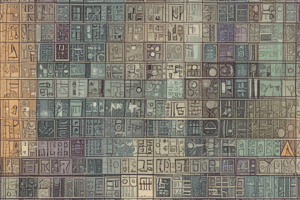Podcast
Questions and Answers
What is the primary characteristic of equivalent fractions?
What is the primary characteristic of equivalent fractions?
- They have the same denominator.
- They have the same numerator.
- They have different values.
- They represent the same portion of a whole. (correct)
Which of the following is NOT a method for generating equivalent fractions?
Which of the following is NOT a method for generating equivalent fractions?
- Dividing the numerator and denominator by the same number.
- Adding the same number to both the numerator and denominator. (correct)
- Using a fraction equivalent to 1 for multiplication.
- Multiplying the numerator and denominator by the same number.
What is meant by 'simplifying fractions'?
What is meant by 'simplifying fractions'?
- Finding a fraction with a larger denominator.
- Representing a fraction with larger numbers.
- Reducing a fraction to its lowest terms. (correct)
- Increasing the value of a fraction.
How is the greatest common factor (GCF) used in simplifying fractions?
How is the greatest common factor (GCF) used in simplifying fractions?
Which of the following correctly states a common error when working with equivalent fractions?
Which of the following correctly states a common error when working with equivalent fractions?
When adjusting a recipe that calls for $\frac{2}{3}$ cup of flour, which of the following would represent an equivalent measurement for a larger batch?
When adjusting a recipe that calls for $\frac{2}{3}$ cup of flour, which of the following would represent an equivalent measurement for a larger batch?
Which calculation demonstrates generating an equivalent fraction for $\frac{3}{5}$?
Which calculation demonstrates generating an equivalent fraction for $\frac{3}{5}$?
Why are equivalent fractions useful in real-world scenarios?
Why are equivalent fractions useful in real-world scenarios?
Flashcards
Equivalent Fractions
Equivalent Fractions
Fractions that represent the same portion or part of a whole, even though they may look different.
What are equivalent fractions?
What are equivalent fractions?
Fractions that represent the same value despite having different numerators and denominators.
Visualizing Equivalent Fractions
Visualizing Equivalent Fractions
A visual representation (like a fraction bar or circle) helps illustrate that different fractions can represent the same portion.
Generating Equivalent Fractions
Generating Equivalent Fractions
Signup and view all the flashcards
Simplifying Fractions
Simplifying Fractions
Signup and view all the flashcards
What is simplifying fractions?
What is simplifying fractions?
Signup and view all the flashcards
Common Errors with Equivalent Fractions
Common Errors with Equivalent Fractions
Signup and view all the flashcards
Real-world applications of equivalent fractions
Real-world applications of equivalent fractions
Signup and view all the flashcards
Study Notes
Introduction to Equivalent Fractions
- Equivalent fractions represent the same portion or part of a whole, even though they may look different.
- They have the same value but different numerators and denominators.
- Finding equivalent fractions involves multiplying or dividing both the numerator and denominator by the same non-zero number.
Identifying Equivalent Fractions
- Visual models, such as fraction bars or circles, can help visualize equivalent fractions.
- Comparing shaded portions of models helps confirm equivalence.
- Equivalent fractions are easily identified by performing simple calculations involving multiplication or division.
Generating Equivalent Fractions
- To find equivalent fractions, a given fraction can be multiplied or divided by a fraction equivalent to 1 (i.e., a fraction where the numerator and denominator are the same number).
- Multiplying both the numerator and denominator of a fraction by the same number results in an equivalent fraction.
- Dividing both the numerator and denominator of a fraction by the same number (which creates a common factor) also results in an equivalent fraction.
Simplifying Fractions
- Simplifying fractions involves reducing a fraction to its lowest terms.
- This process retains the same value of the original fraction while using the smallest possible numerator and denominator.
- Finding the greatest common factor (GCF) of the numerator and denominator is a crucial step for simplifying. Dividing both the numerator and denominator by their GCF yields the simplified equivalent fraction.
Common Errors and Pitfalls
- Students might confuse multiplying or dividing by a fraction that is not equivalent to 1 when generating equivalent fractions.
- Incorrectly identifying multiples and factors during simplification can lead to incorrect results.
- Ignoring the fundamental principle that multiplying (or dividing) both numerator and denominator by the same non-zero number preserves the fraction's value can cause errors.
Real-World Applications
- Equivalent fractions are essential for comparing fractions in various contexts. For instance, determining which of two recipe ingredients requires a larger portion often involves comparing fractions through equivalent expressions.
- Adjusting measurements in baking or constructing involves equivalent fractions.
- In real-life situations that require fractions like shared food portions or measuring time, equivalent fractions are key to understanding the relation between fractional parts.
Studying That Suits You
Use AI to generate personalized quizzes and flashcards to suit your learning preferences.




